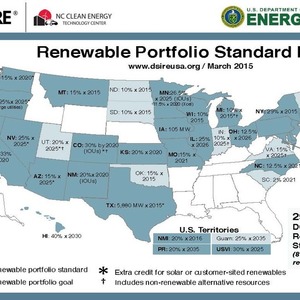Bills aim to raise, alter, remove state RPS programs




U.S. Department of Energy
May 20, 2015
BY Anna Simet
While Hawaii has made recently headlines in the renewable policy world with plans to raise its renewable portfolio standard (RPS) higher than any state has to date—100 percent renewables by 2045—several states have seen recent attempts to freeze, dismantle or alter their programs.
At the end of April, a North Carolina bill that would have reduced by half the lifetime and targets of North Carolina’s RPS of 12.5 percent was voted down in the state House Public Utilities Committee. But another bill concerning the RPS, H.B. 760, passed the House on May 6. If it becomes law, the bill will freeze the RPS compliance percentage at 6 percent, rather than raising it in 2018, to examine whether modifications are needed.
In Texas, the Senate passed S.B. 931 in April, which will eliminate the state’s RPS. The reasoning of supporters of the bill, which is now in the House, is that since the state’s goal of 10,000 MW of wind and solar energy by 2025 has been met, renewables no longer need help from the state.
Advertisement
Advertisement
Following several attempts to hamper the state’s RPS, in Kansas, Gov. Sam Brownback unveiled a plan in early May to repeal the state’s target of 20 percent renewable energy by 2020 and replace it with a voluntary goal. S.B.91 has passed both the House and the Senate and awaits the governor’s signature.
In Minnesota, a proposed bill will allow biomass, hydro and wind to meet solar RPS requirements, so long as the resource is less expensive than solar. The bill passed the House in April and has been twice read in the Senate. Minnesota requires utilities to provide 25 percent of their total electrical generation from renewable sources like wind, hydrogen and solar power by 2025. In 2013, further legislation was enacted to create a 1.5 percent solar standard for public utilities.
In Washington, proposed bill S.B. 5735 will allow utilities to meet RPS targets—15 percent by 2020— through carbon reduction investments, which are defined as investments in support of eligible projects or actions that reduce, prevent, or remove emissions of greenhouse gases.
In Vermont, the Senate voted 22-6 to pass H.B. 40, a renewable energy standard that requires utilities to buy and sell more renewable electricity beginning in 2017. The bill received final approval in the House and is now at Gov. Peter Shumlin’s desk. The bill incentivizes the build-out of 400 MW of new renewable energy by 2032 and incentivizes utilities to reduce customers’ fossil fuel consumption via heat pumps and electric cars.
Advertisement
Advertisement
In New Jersey, legislation currently being considered in the Senate, S.B. 2444, would require the state source 80 percent of its electricity from renewables by 2050, raising the state’s current policy goal of 22.5 percent by 2022.
In Michigan, introduced legislation would increase the states renewable energy target to 20 percent by 2022, doubling its target of 10 percent by 2015.
Outside of state policy, several U.S. Senators recently introduced a bill for a federal renewable electricity standard. The legislation, S.B. 1264, was introduced May 11 and referred to the Committee on Energy and Natural Resources. The RES requirement would phase in, starting at 7.5 percent in 2015 and gradually increase to 30 percent in 2030 and thereafter, through 2039.
Upcoming Events





